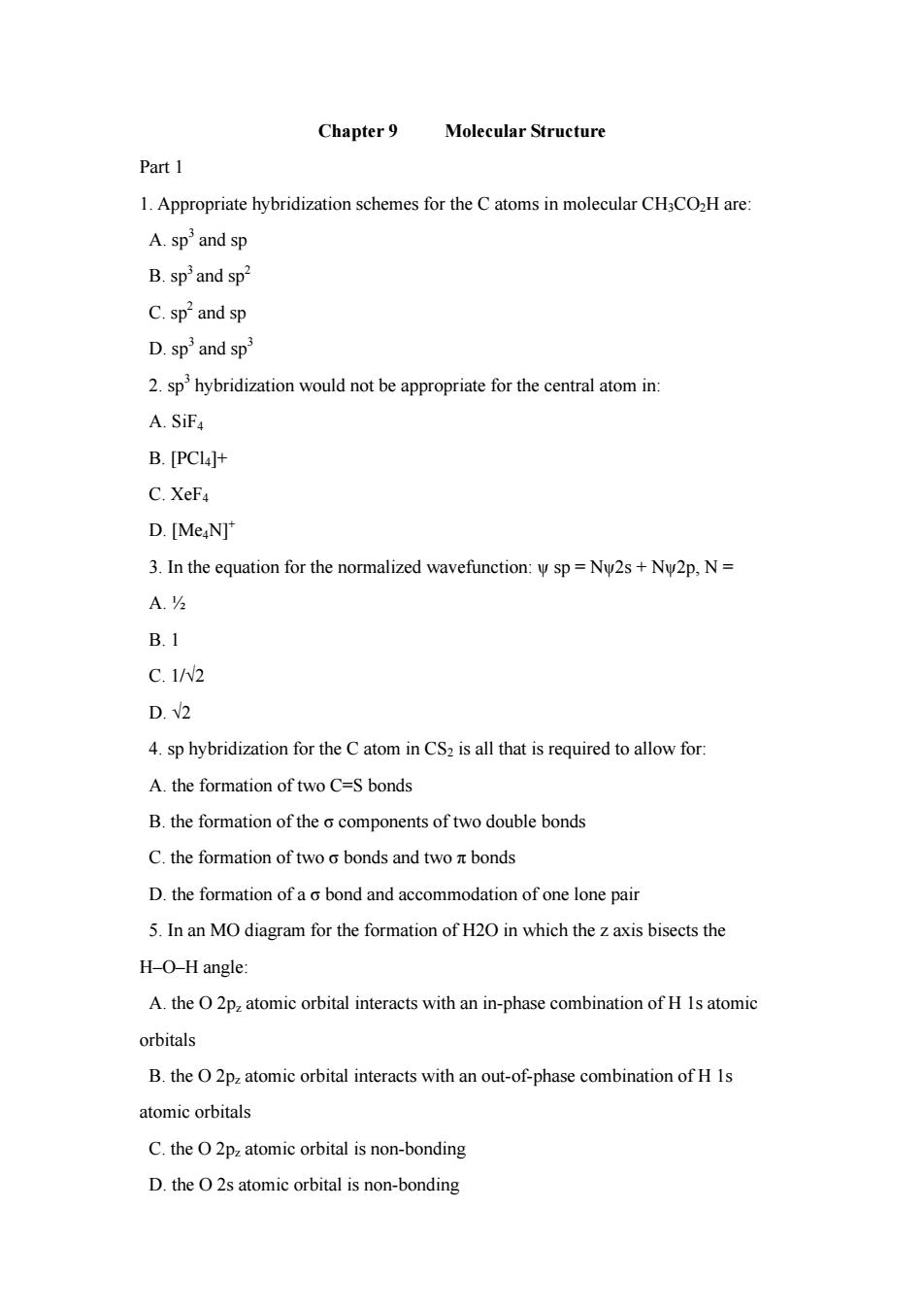
Chapter9 Molecular Structure Part 1 1.Appropriate hybridization schemes for the C atoms in molecular CH3COH are: A.sp and sp B.spand sp C.sp2 and sp D.spand sp 2.sphybridization would not be appropriate for the central atom in: A.SiF4 B.[PCL]+ C.XeFa D.[MeN]' 3.In the equation for the normalized wavefunction:wsp=Ny2s+Ny2p,N= A.⅓ B.1 C.1/W2 D.2 4.sp hybridization for the C atom in CS2 is all that is required to allow for A.the formation of two C=S bonds B.the formation of the c components of two double bonds C.the formation of bonds and two bonds D.the formation of ac bond and accommodation of one lone pair 5.In an MO diagram for the formation of H20 in which the zaxis bisects the H-O-H angle: A.orbital interacts with an in-phase combination of H Is atomic orbitals B.the O2pz atomic orbital interacts with an out-of-phase combination of H Is atomic orbitals C.the 2patomic orbital is non-bonding D.the2s atomic orbital is non-bonding
Chapter 9 Molecular Structure Part 1 1. Appropriate hybridization schemes for the C atoms in molecular CH3CO2H are: A. sp3 and sp B. sp3 and sp2 C. sp2 and sp D. sp3 and sp3 2. sp3 hybridization would not be appropriate for the central atom in: A. SiF4 B. [PCl4]+ C. XeF4 D. [Me4N]+ 3. In the equation for the normalized wavefunction: ψ sp = Nψ2s + Nψ2p, N = A. ½ B. 1 C. 1/√2 D. √2 4. sp hybridization for the C atom in CS2 is all that is required to allow for: A. the formation of two C=S bonds B. the formation of the σ components of two double bonds C. the formation of two σ bonds and two π bonds D. the formation of a σ bond and accommodation of one lone pair 5. In an MO diagram for the formation of H2O in which the z axis bisects the H–O–H angle: A. the O 2pz atomic orbital interacts with an in-phase combination of H 1s atomic orbitals B. the O 2pz atomic orbital interacts with an out-of-phase combination of H 1s atomic orbitals C. the O 2pz atomic orbital is non-bonding D. the O 2s atomic orbital is non-bonding
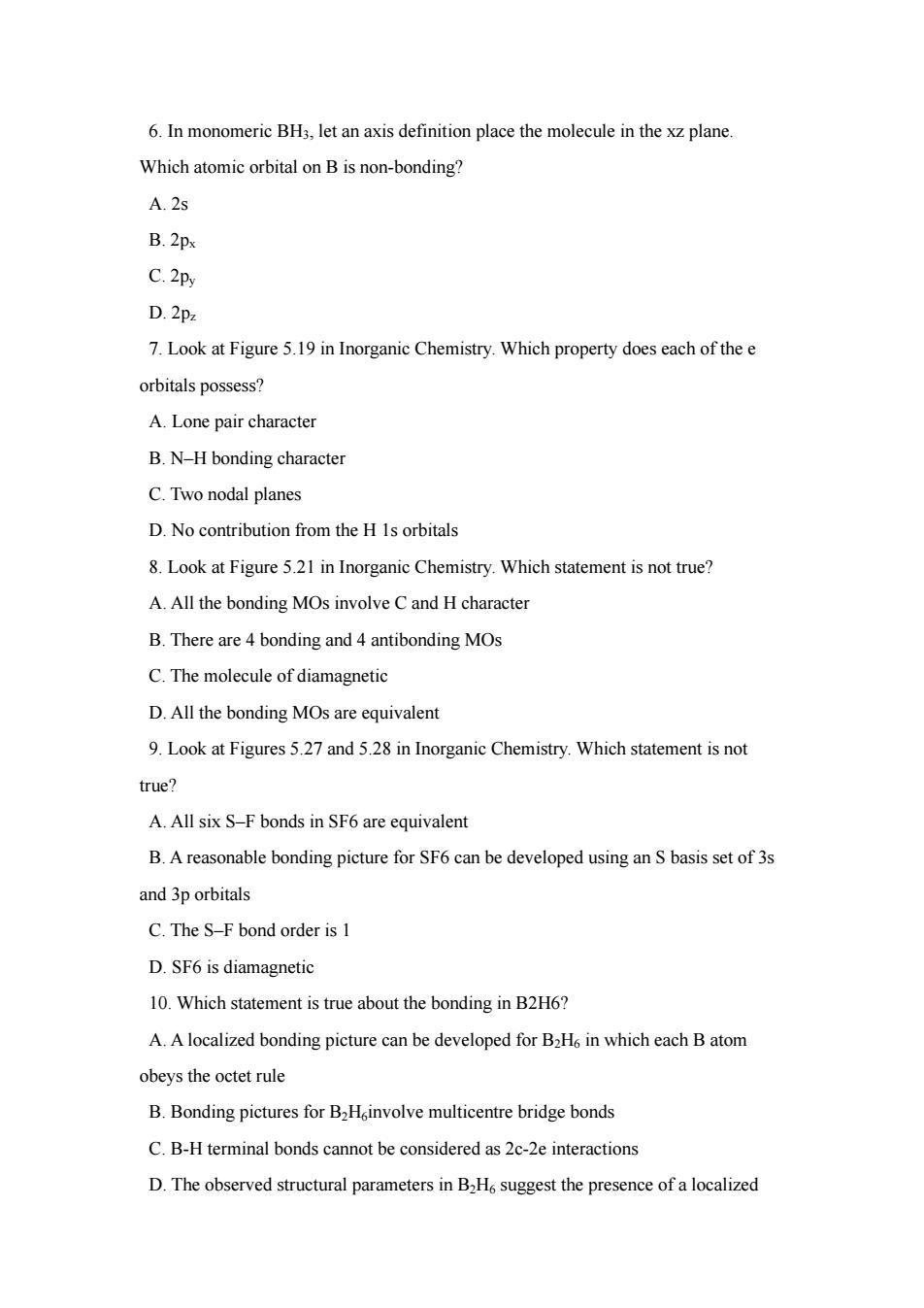
6.In monomeric BH3,let an axis definition place the molecule in the xz plane. Which atomic orbital on B is non-bonding? A.2s B.2px C.2py D.2pz 7.Look at Figure 5.19 in Inorganic Chemistry.Which property does each of the e orbitals possess? A.Lone pair character B.N-H bonding character C.Two nodal planes D.No contribution from the HIs orbitals 8.Look at Figure 5.21 in Inorganic Chemistry.Which statement is not true? A.All the bonding MOs involve C and H character B.There are 4 bonding and 4 antibonding MOs C.The molecule of diamagnetic D.All the bonding MOs are equivalent 9.Look at Figures 5.27and 5.28 in Inorganic Chemistry.Which statement is not true? A.All six S-F bonds in SF6 are equivalent B.Areasonable bonding picture for SF6can be developed using an basis set of 3s and 3p orbitals C.The S-F bond order is 1 D.SF6 is diamagnetic 10.Which statement is true about the bonding in B2H6? A.A localized bonding picture can be developed for B2H in which each B atom obeys the octet rule B.Bonding pictures for B2H involve multicentre bridge bonds C.B-H terminal bonds cannot be considered as 2c-2e interactions D.The observed structural parameters in B2H suggest the presence of a localized
6. In monomeric BH3, let an axis definition place the molecule in the xz plane. Which atomic orbital on B is non-bonding? A. 2s B. 2px C. 2py D. 2pz 7. Look at Figure 5.19 in Inorganic Chemistry. Which property does each of the e orbitals possess? A. Lone pair character B. N–H bonding character C. Two nodal planes D. No contribution from the H 1s orbitals 8. Look at Figure 5.21 in Inorganic Chemistry. Which statement is not true? A. All the bonding MOs involve C and H character B. There are 4 bonding and 4 antibonding MOs C. The molecule of diamagnetic D. All the bonding MOs are equivalent 9. Look at Figures 5.27 and 5.28 in Inorganic Chemistry. Which statement is not true? A. All six S–F bonds in SF6 are equivalent B. A reasonable bonding picture for SF6 can be developed using an S basis set of 3s and 3p orbitals C. The S–F bond order is 1 D. SF6 is diamagnetic 10. Which statement is true about the bonding in B2H6? A. A localized bonding picture can be developed for B2H6 in which each B atom obeys the octet rule B. Bonding pictures for B2H6involve multicentre bridge bonds C. B-H terminal bonds cannot be considered as 2c-2e interactions D. The observed structural parameters in B2H6 suggest the presence of a localized
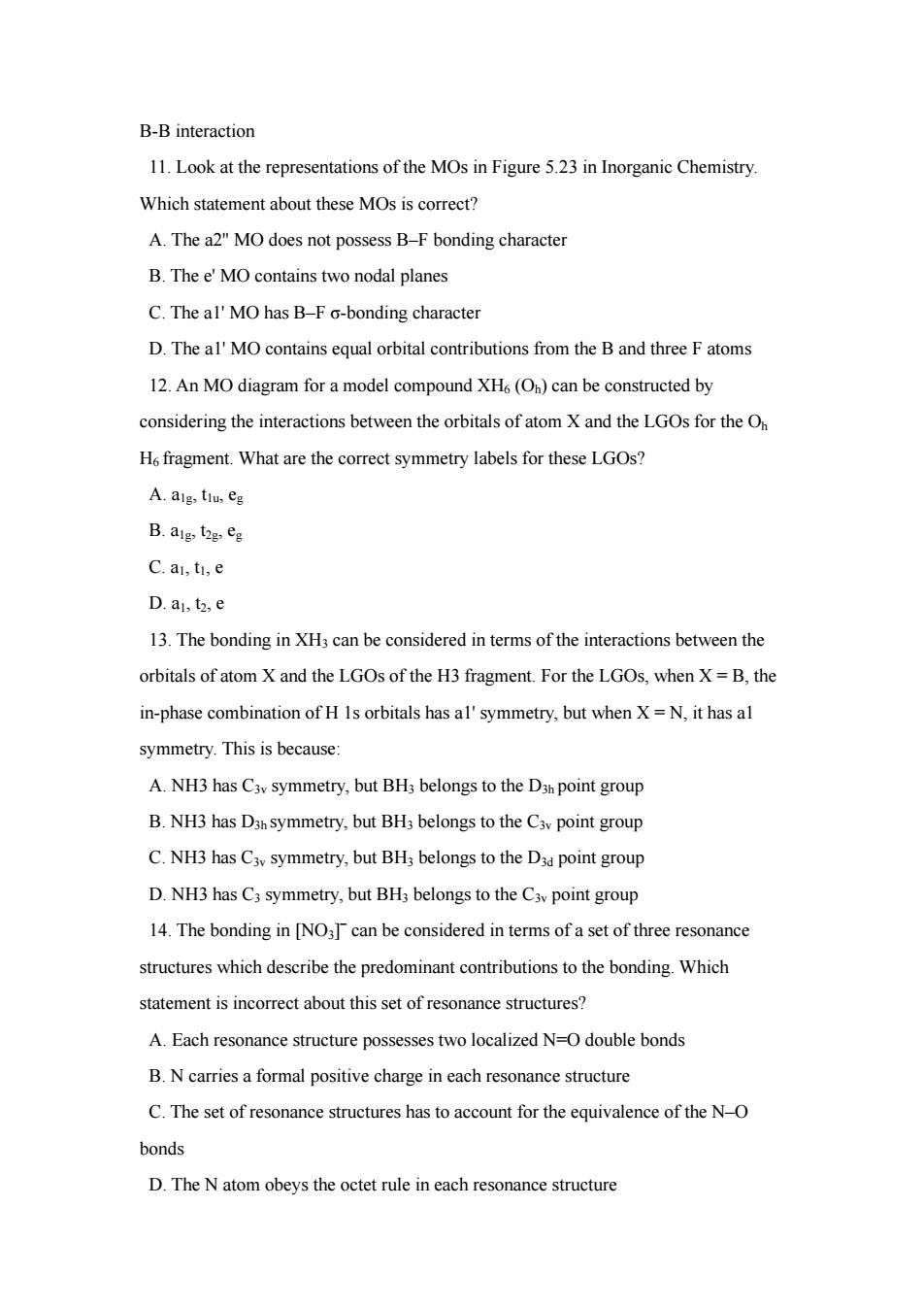
B-B interaction 11.Look at the representations of the MOs in Figure 5.23 in Inorganic Chemistry. Which statement about these MOs is correct? A.The a2"MO does not possess B-F bonding character B.The e'MO contains two nodal planes C.The al'MO has B-F o-bonding character D.The al'MO contains equal orbital contributions from the Band three Fatoms 12.An MO diagram for a model compound XH(On)can be constructed by considering the interactions between the orbitals of atom X and the LGOs for the On Hfragment.What are the correct symmetry labels for these LGOs? A.aig,tiu.eg B.aig,tg eg C.ai,ti,e D.a,t,e 13.The bonding in XH3 can be considered in terms of the interactions between the orbitals of atom X and the LGOs of the H3 fragment.For the LGOs,when X=B,the in-phase combination of H Is orbitals has al'symmetry,but when X=N,it has al symmetry.This is because A.NH3 has Csymmetry,but BH3 belongs to the D3h point group B.NH3 has Dsh symmetry,but BH3 belongs to the C3v point group C.NH3 has C symmetry,but BH3 belongs to the Da point group D.NH3 has C3 symmetry,but BH3 belongs to the Cpoint group 14.The bonding in [NO can be considered in terms of a set of three resonance structures which describe the predominant contributions to the bonding.Which statement is incorrect about this set of resonance structures? A.Each resonance structure possesses two localized N=double bonds B.N carries a formal positive charge in each resonance structure C.The set of resonance structures has to account for the equivalence of the N-O bonds D.The N atom obeys the octet rule in each resonance structure
B-B interaction 11. Look at the representations of the MOs in Figure 5.23 in Inorganic Chemistry. Which statement about these MOs is correct? A. The a2'' MO does not possess B–F bonding character B. The e' MO contains two nodal planes C. The a1' MO has B–F σ-bonding character D. The a1' MO contains equal orbital contributions from the B and three F atoms 12. An MO diagram for a model compound XH6 (Oh) can be constructed by considering the interactions between the orbitals of atom X and the LGOs for the Oh H6 fragment. What are the correct symmetry labels for these LGOs? A. a1g, t1u, eg B. a1g, t2g, eg C. a1, t1, e D. a1, t2, e 13. The bonding in XH3 can be considered in terms of the interactions between the orbitals of atom X and the LGOs of the H3 fragment. For the LGOs, when X = B, the in-phase combination of H 1s orbitals has a1' symmetry, but when X = N, it has a1 symmetry. This is because: A. NH3 has C3v symmetry, but BH3 belongs to the D3h point group B. NH3 has D3h symmetry, but BH3 belongs to the C3v point group C. NH3 has C3v symmetry, but BH3 belongs to the D3d point group D. NH3 has C3 symmetry, but BH3 belongs to the C3v point group 14. The bonding in [NO3] – can be considered in terms of a set of three resonance structures which describe the predominant contributions to the bonding. Which statement is incorrect about this set of resonance structures? A. Each resonance structure possesses two localized N=O double bonds B. N carries a formal positive charge in each resonance structure C. The set of resonance structures has to account for the equivalence of the N–O bonds D. The N atom obeys the octet rule in each resonance structure
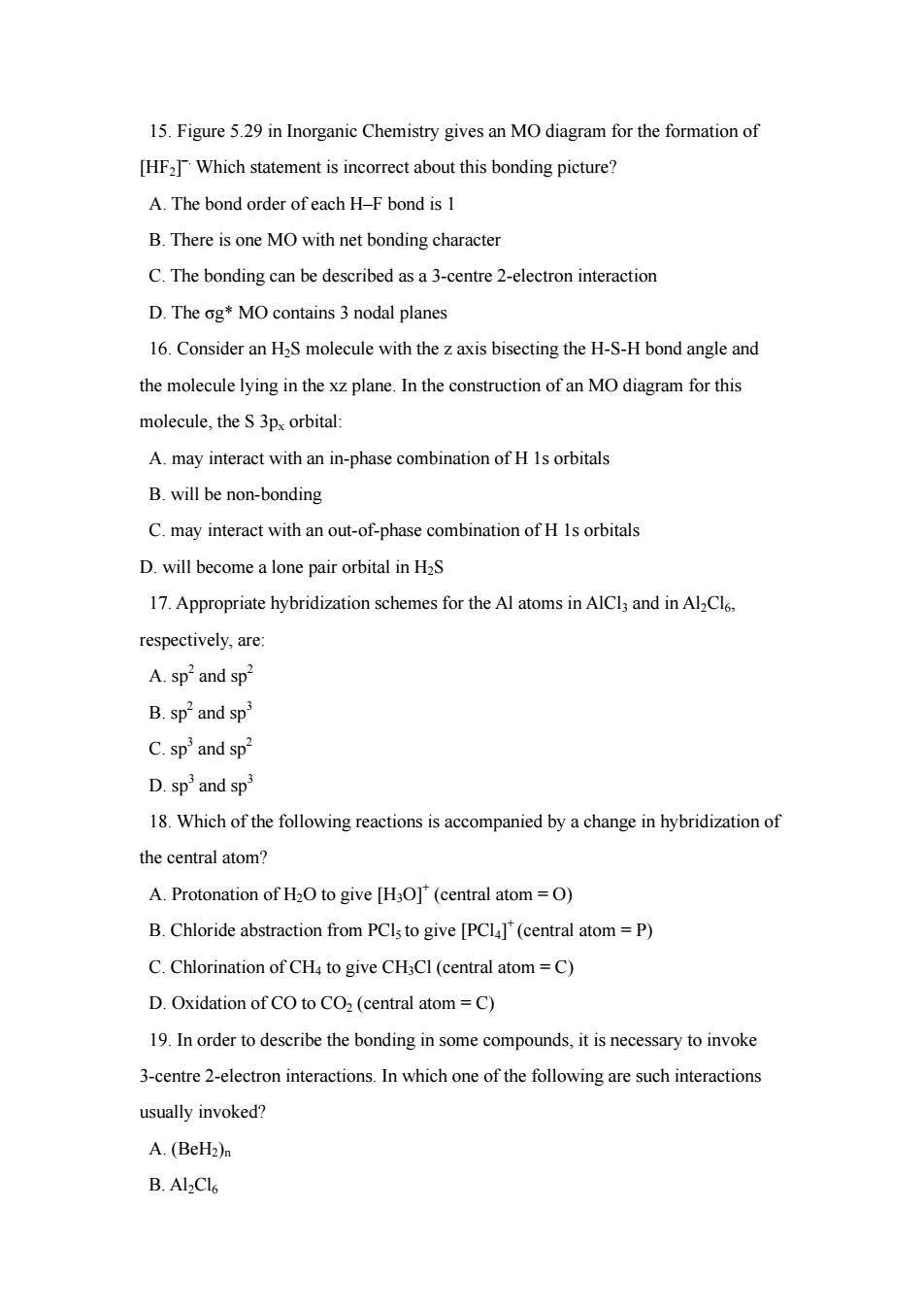
15.Figure 5.29 in Inorganic Chemistry gives an MO diagram for the formation of [HF2 Which statement is incorrect about this bonding picture? A.The bond order of each H-F bond is 1 B.There is one MO with net bonding character C.The bonding can be described as a 3-centre 2-electron interaction D.The og*MO contains 3 nodal planes 16.Consider an H2S molecule with the z axis bisecting the H-S-H bond angle and the molecule lying in the xz plane.In the construction of an MO diagram for this molecule,the S 3px orbital: A.may interact with an in-phase combination of H Is orbitals B.will be non-bonding C.may interact with an out-of-phase combination of H Is orbitals D.will become a lone pair orbital in H2S 17.Appropriate hybridization schemes for the Al atoms in AICl and in AlCl respectively,are A.sp2and sp2 B.sp and sp C.sp and sp2 D.spand sp 18.Which of the following reactions is accompanied by a change in hybridization of the central atom? A.Protonation of H2O to give [HO](central atom=O) B.Chloride abstraction from PCls to give [PCl(central atom=P) C.Chlorination of CHa to give CH3Cl (central atom=C) D.Oxidation of COto CO(central atom=C) 19.In order to describe the bonding in some compounds,it is necessary to invoke 3-centre 2-electron interactions.In which one of the following are such interactions usually invoked? A.(BeH2) B.Al2Cl6
15. Figure 5.29 in Inorganic Chemistry gives an MO diagram for the formation of [HF2] –. Which statement is incorrect about this bonding picture? A. The bond order of each H–F bond is 1 B. There is one MO with net bonding character C. The bonding can be described as a 3-centre 2-electron interaction D. The σg* MO contains 3 nodal planes 16. Consider an H2S molecule with the z axis bisecting the H-S-H bond angle and the molecule lying in the xz plane. In the construction of an MO diagram for this molecule, the S 3px orbital: A. may interact with an in-phase combination of H 1s orbitals B. will be non-bonding C. may interact with an out-of-phase combination of H 1s orbitals D. will become a lone pair orbital in H2S 17. Appropriate hybridization schemes for the Al atoms in AlCl3 and in Al2Cl6, respectively, are: A. sp2 and sp2 B. sp2 and sp3 C. sp3 and sp2 D. sp3 and sp3 18. Which of the following reactions is accompanied by a change in hybridization of the central atom? A. Protonation of H2O to give [H3O]+ (central atom = O) B. Chloride abstraction from PCl5 to give [PCl4] + (central atom = P) C. Chlorination of CH4 to give CH3Cl (central atom = C) D. Oxidation of CO to CO2 (central atom = C) 19. In order to describe the bonding in some compounds, it is necessary to invoke 3-centre 2-electron interactions. In which one of the following are such interactions usually invoked? A. (BeH2)n B. Al2Cl6

C.(BeCl2) D.SizH6 20.Which statement is true about orbitals with tsymmetry? A.MOs with t symmetry are found for molecules belonging to the Ta point group B.Each MO in a t2 set oforbitals is centrosymmetric C.Aset oft MOs consists of two degenerate orbitals D.MOs with t symmetry are found for molecules belonging to the C point group ANSWERS: 1.Appropriate hybridization schemes for the C atoms in molecular CH3CO2H are: Correct Answer:spand sp 2.sp3 hybridization would not be appropriate for the central atom in: Correct Answer:XeF4 3.In the equation for the normalized wavefunction:s=+Nzp,N= Correct Answer:1/2 4.sp hybridization for the Catom in CS is all that is required to allow for: Correct Answer:the formation of the o components of two double bonds 5.In an MO diagram for the formation of H in which thezaxis bisects the H-O-H angle: Correct Answer:the O2pz atomic orbital interacts with an in-phase combination of H 1s atomic orbitals 6.In monomeric BH3,let an axis definition place the molecule in the xz plane Which atomic orbital on B is non-bonding? Correct Answer:2py 7.Look at Figure 5.19in Inorganic Chemistry.Which property does each of thee orbitals possess? Correct Answer:N-H bonding character 8.Look at Figure 5.21 in Inorganic Chemistry.Which statement is not true? Correct Answer:All the bonding MOs are equivalent 9.Look at Figures 5.27 and 5.28 in Inorganic Chemistry.Which statement is not
C. (BeCl2)n D. Si2H6 20. Which statement is true about orbitals with t2g symmetry? A. MOs with t2g symmetry are found for molecules belonging to the Td point group B. Each MO in a t2g set of orbitals is centrosymmetric C. A set of t2g MOs consists of two degenerate orbitals D. MOs with t2g symmetry are found for molecules belonging to the C2v point group ANSWERS: 1. Appropriate hybridization schemes for the C atoms in molecular CH3CO2H are: Correct Answer: sp3 and sp2 2. sp3 hybridization would not be appropriate for the central atom in: Correct Answer: XeF4 3. In the equation for the normalized wavefunction: ψ sp = Nψ2s + Nψ2p, N = Correct Answer: 1/√2 4. sp hybridization for the C atom in CS2 is all that is required to allow for: Correct Answer: the formation of the σ components of two double bonds 5. In an MO diagram for the formation of H2O in which the z axis bisects the H–O–H angle: Correct Answer: the O 2pz atomic orbital interacts with an in-phase combination of H 1s atomic orbitals 6. In monomeric BH3, let an axis definition place the molecule in the xz plane. Which atomic orbital on B is non-bonding? Correct Answer: 2py 7. Look at Figure 5.19 in Inorganic Chemistry. Which property does each of the e orbitals possess? Correct Answer: N–H bonding character 8. Look at Figure 5.21 in Inorganic Chemistry. Which statement is not true? Correct Answer: All the bonding MOs are equivalent 9. Look at Figures 5.27 and 5.28 in Inorganic Chemistry. Which statement is not
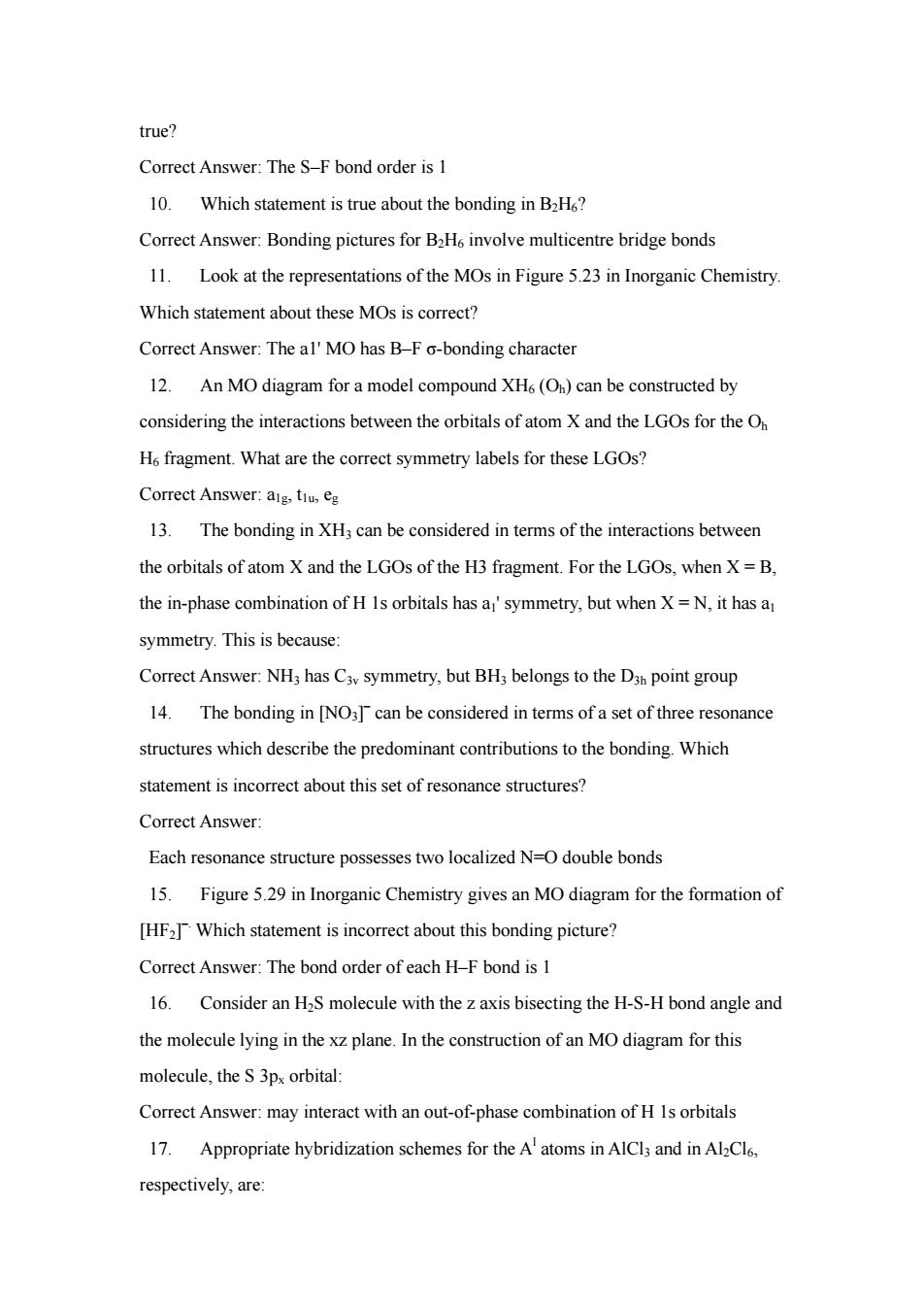
true? Correct Answer:The S-F bond order is 1 10.Which statement is true about the bonding in B2H? Correct Answer:Bonding pictures for B2H involve multicentre bridge bonds 11.Look at the representations of the MOs in Figure 5.23 in Inorganic Chemistry. Which statement about these MOs is correct? Correct Answer:The al'MO has B-F a-bonding character 12.An MO diagram for a model compound XH(On)can be constructed by considering the interactions between the orbitals of atom X and the LGOs for theO H fragment.What are the correct symmetry labels for these LGOs? Correct Answer:aig, 13.The bonding in XH3 can be considered in terms of the interactions between the orbitals of atom X and the LGOs of the H3 fragment.For the LGOs,when X=B, the in-phase combination of H Is orbitals has a'symmetry,but when X=N,it has a symmetry.This is because: Correct Answer:NH,has C3 symmetry,but BH,belongs to the D3h point group 14.The bonding in [NO can be considered in terms of a set of three resonance structures which describe the predominant conributions to the bonding.Which statement is incorrect about this set of resonance structures? Correct Answer: Each resonance structure possesses two localized N-double bonds 15.Figure 5.29 in Inorganic Chemistry gives an MO diagram for the formation of [HFWhich statement is incorrect about this bonding picture? Correct Answer:The bond order of each H-F bond is I 16.Consider an H2S molecule with the z axis bisecting the H-S-H bond angle and the molecule lying in the xz plane.In the construction of an MO diagram for this molecule,the S3px orbital: Correct Answer:may interact with an out-of-phase combination of H Is orbitals 17.Appropriate hybridization schemes for the A'atoms in AlCls and in AlzCl respectively,are
true? Correct Answer: The S–F bond order is 1 10. Which statement is true about the bonding in B2H6? Correct Answer: Bonding pictures for B2H6 involve multicentre bridge bonds 11. Look at the representations of the MOs in Figure 5.23 in Inorganic Chemistry. Which statement about these MOs is correct? Correct Answer: The a1' MO has B–F σ-bonding character 12. An MO diagram for a model compound XH6 (Oh) can be constructed by considering the interactions between the orbitals of atom X and the LGOs for the Oh H6 fragment. What are the correct symmetry labels for these LGOs? Correct Answer: a1g, t1u, eg 13. The bonding in XH3 can be considered in terms of the interactions between the orbitals of atom X and the LGOs of the H3 fragment. For the LGOs, when X = B, the in-phase combination of H 1s orbitals has a1' symmetry, but when X = N, it has a1 symmetry. This is because: Correct Answer: NH3 has C3v symmetry, but BH3 belongs to the D3h point group 14. The bonding in [NO3] – can be considered in terms of a set of three resonance structures which describe the predominant contributions to the bonding. Which statement is incorrect about this set of resonance structures? Correct Answer: Each resonance structure possesses two localized N=O double bonds 15. Figure 5.29 in Inorganic Chemistry gives an MO diagram for the formation of [HF2] –. Which statement is incorrect about this bonding picture? Correct Answer: The bond order of each H–F bond is 1 16. Consider an H2S molecule with the z axis bisecting the H-S-H bond angle and the molecule lying in the xz plane. In the construction of an MO diagram for this molecule, the S 3px orbital: Correct Answer: may interact with an out-of-phase combination of H 1s orbitals 17. Appropriate hybridization schemes for the Al atoms in AlCl3 and in Al2Cl6, respectively, are:

Correct Answer:sp2and sp' 18.Which of the following reactions is accompanied by a change in hybridization of the central atom? Correct Answer:Chloride abstraction from PCls to give [PCl](central atom=P) 19.In order to describe the bonding in some compounds,it is necessary to invoke 3-centre 2-electron interactions.In which one of the following are such interactions usually invoked? Correct Answer:(BeH2)n 20.Which statement is true about orbitals with ta symmetry? Correct Answer:Each MO in atset of orbitals is centrosymmetric Pat2 1.What kind of hybridization of oxygen's atomic orbitals is there in the water molecule? C sp C spsp sp'd C sp'd? 2.An octahedral species such as SF always has what kind of hybridization of the central atom? C sp C sp sp C sp'd sp'd 3.If a central carbon atom is sphybridized,what shape of molecule results? C linear trigonal planar bipyramidal Coctahedral 4.If a carbon atom is sp hybridized,how many p-orbitals are left over to make bonds? 00 01 02 03
Correct Answer: sp2 and sp3 18. Which of the following reactions is accompanied by a change in hybridization of the central atom? Correct Answer: Chloride abstraction from PCl5 to give [PCl4] + (central atom = P) 19. In order to describe the bonding in some compounds, it is necessary to invoke 3-centre 2-electron interactions. In which one of the following are such interactions usually invoked? Correct Answer: (BeH2)n 20. Which statement is true about orbitals with t2g symmetry? Correct Answer: Each MO in a t2g set of orbitals is centrosymmetric Pat 2 1. What kind of hybridization of oxygen's atomic orbitals is there in the water molecule? sp sp 2 sp3 sp3 d sp3 d2 2. An octahedral species such as SF6 always has what kind of hybridization of the central atom? sp sp2 sp3 sp3 d sp3 d2 3. If a central carbon atom is sp2 hybridized, what shape of molecule results? linear trigonal planar tetrahedral trigonal bipyramidal octahedral 4. If a carbon atom is sp hybridized, how many p-orbitals are left over to make bonds? 0 1 2 3
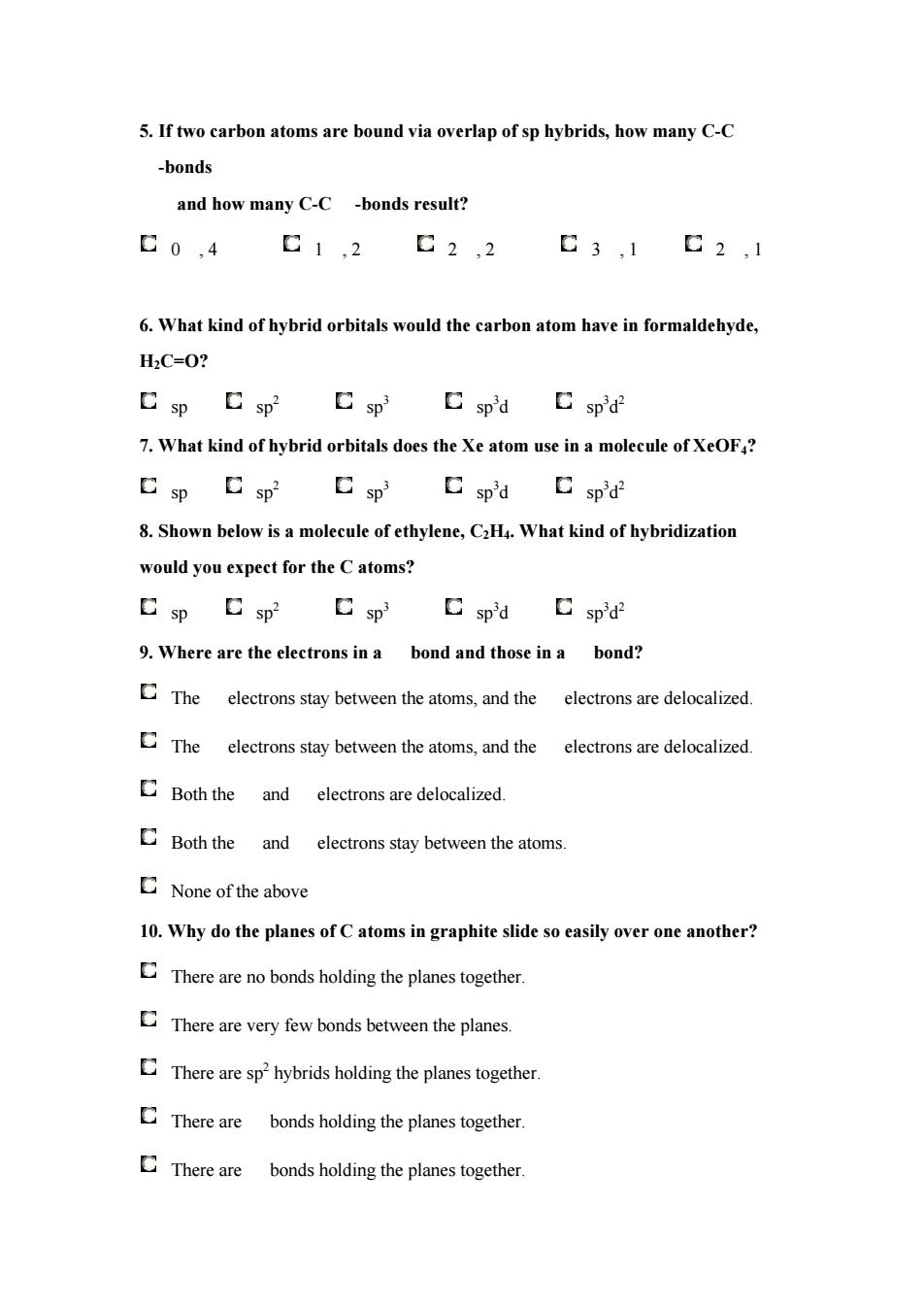
5.If two carbon atoms are bound via overlap of sp hybrids,how many C-C -bonds and how many C-C -bonds result? C0,4口1,2口2,203,1口2,1 6.What kind of hybrid orbitals would the carbon atom have in formaldehyde, H2C=0? Csp口sp2 C sp C sp'd C sp'd 7.What kind of hybrid orbitals does the Xe atom use in a molecule of XeOF? C sp C spsp C sp'd C sp'd? 8.Shown below is a molecule of ethylene,C2H.What kind of hybridization would you expect for the C atoms? sp E sp:E sp C sp'd C sp'd 9.Where are the electrons in a bond and those in a bond? The eletros stay between the atoms,and the elctros are delocalized. The to stay between the atoms,and the oare delcalized. Both the and electrons are delocalized Both the and electros stay between the atoms. None of the above 10.Why do the planes of C atoms in graphite slide so easily over one another? Thereareo bonds holding the planes toether. There are very few bonds between the planes. There holding the planes together There are bonds holding the planes together. There are bonds holding the planes together
5. If two carbon atoms are bound via overlap of sp hybrids, how many C-C -bonds and how many C-C -bonds result? 0 , 4 1 , 2 2 , 2 3 , 1 2 , 1 6. What kind of hybrid orbitals would the carbon atom have in formaldehyde, H2C=O? sp sp 2 sp3 sp3 d sp3 d2 7. What kind of hybrid orbitals does the Xe atom use in a molecule of XeOF4? sp sp 2 sp3 sp3 d sp3 d2 8. Shown below is a molecule of ethylene, C2H4. What kind of hybridization would you expect for the C atoms? sp sp 2 sp3 sp3 d sp3 d2 9. Where are the electrons in a bond and those in a bond? The electrons stay between the atoms, and the electrons are delocalized. The electrons stay between the atoms, and the electrons are delocalized. Both the and electrons are delocalized. Both the and electrons stay between the atoms. None of the above 10. Why do the planes of C atoms in graphite slide so easily over one another? There are no bonds holding the planes together. There are very few bonds between the planes. There are sp2 hybrids holding the planes together. There are bonds holding the planes together. There are bonds holding the planes together
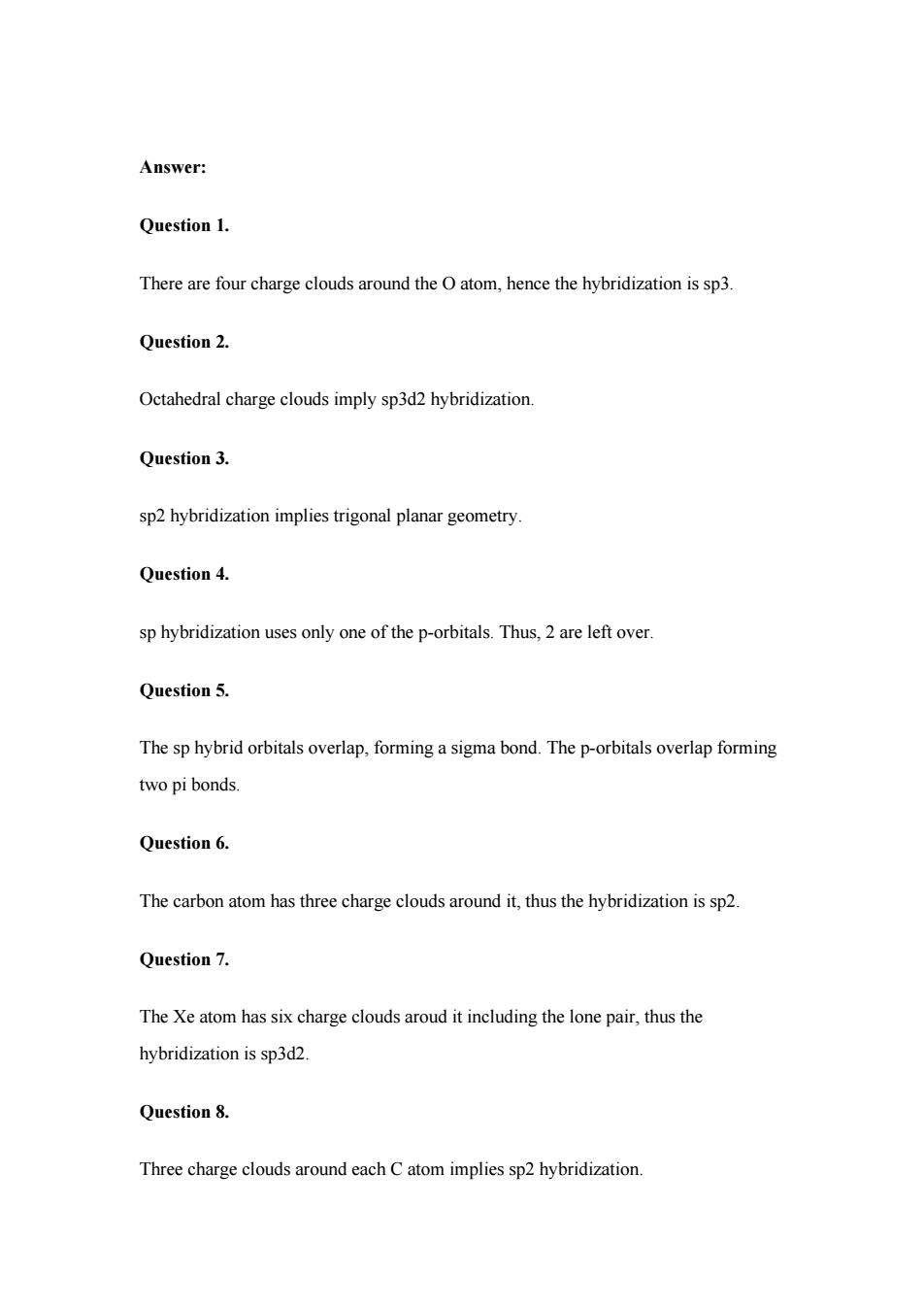
Answer: Question 1. There are four charge clouds around the Oatom,hence the hybridization is sp3 Question 2. Octahedral charge clouds imply sp3d2 hybridization. Question3. sp2 hybridization implies trigonal planar geometry. Question 4. sp hybridization uses only one of the p-orbitals.Thus,2 are left over. Question 5. The sp hybrid orbitals overlap,forming a sigma bond.The p-orbitals overlap forming two pi bonds. Question 6. The carbon atom has three charge clouds around it,thus the hybridization is sp2. Question 7. The Xe atom has six charge clouds aroud it including the lone pair,thus the hybridization is sp3d2. Question 8. Three charge clouds around each Catom implies sp2 hybridization
Answer: Question 1. There are four charge clouds around the O atom, hence the hybridization is sp3. Question 2. Octahedral charge clouds imply sp3d2 hybridization. Question 3. sp2 hybridization implies trigonal planar geometry. Question 4. sp hybridization uses only one of the p-orbitals. Thus, 2 are left over. Question 5. The sp hybrid orbitals overlap, forming a sigma bond. The p-orbitals overlap forming two pi bonds. Question 6. The carbon atom has three charge clouds around it, thus the hybridization is sp2. Question 7. The Xe atom has six charge clouds aroud it including the lone pair, thus the hybridization is sp3d2. Question 8. Three charge clouds around each C atom implies sp2 hybridization
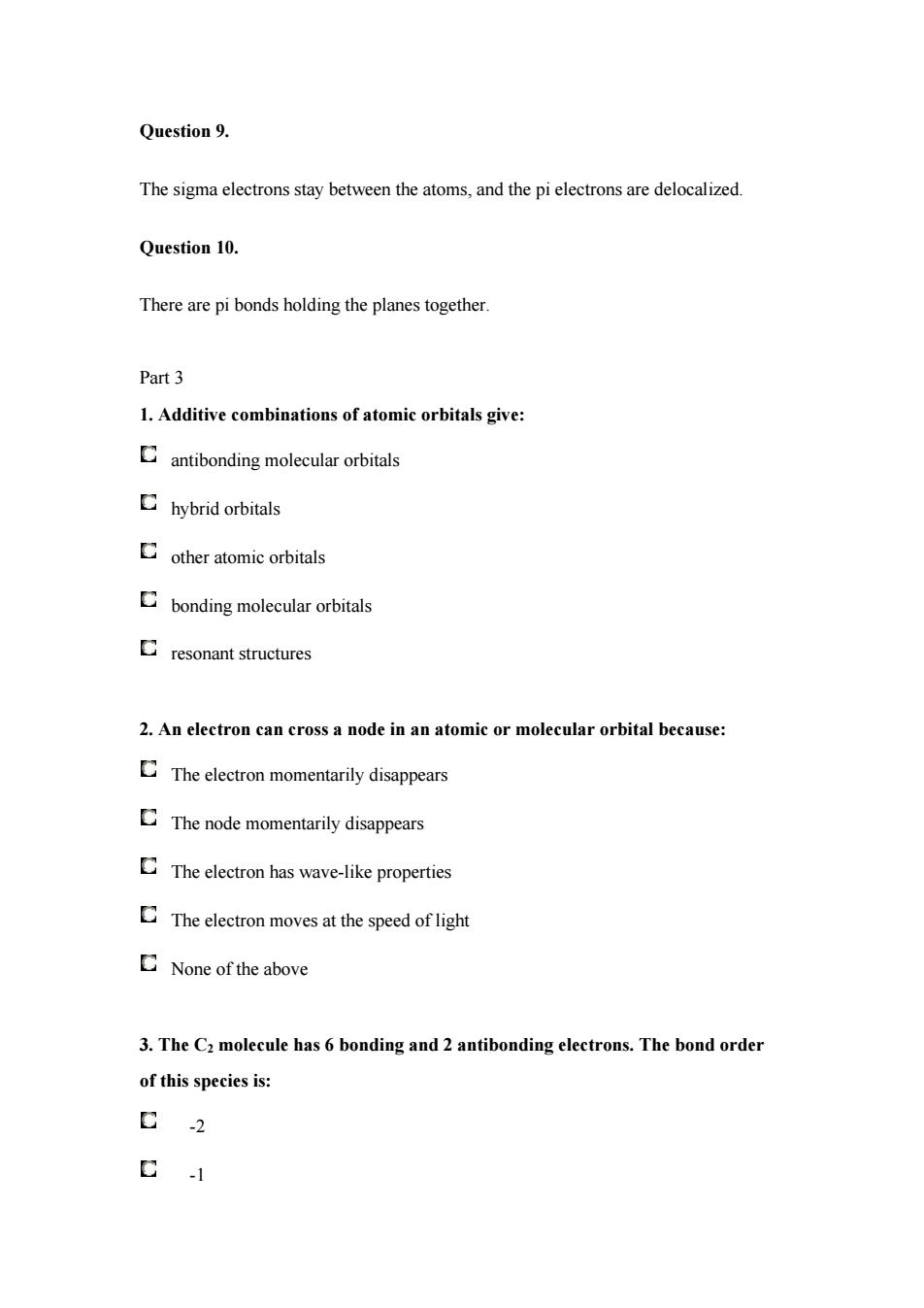
Question 9. The sigma electrons stay between the atoms,and the pi electrons are delocalized. Question 10. There are pi bonds holding the planes together Part3 1.Additive combinations of atomic orbitals give: antibonding oritals hybrid orbitals other atomic orbitals bonding obitals resonant structures 2.An electron can cross a node in an atomic or molecular orbital because: The eltro mmetarily disappears The node momentarily disappears The electron has wave-like properties The electron moves at the speed of light CNone of the above 3.The C2 molecule has 6 bonding and 2 antibonding electrons.The bond order of this species is: 0-2 01
Question 9. The sigma electrons stay between the atoms, and the pi electrons are delocalized. Question 10. There are pi bonds holding the planes together. Part 3 1. Additive combinations of atomic orbitals give: antibonding molecular orbitals hybrid orbitals other atomic orbitals bonding molecular orbitals resonant structures 2. An electron can cross a node in an atomic or molecular orbital because: The electron momentarily disappears The node momentarily disappears The electron has wave-like properties The electron moves at the speed of light None of the above 3. The C2 molecule has 6 bonding and 2 antibonding electrons. The bond order of this species is: -2 -1